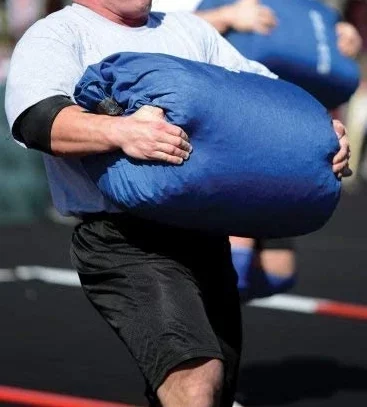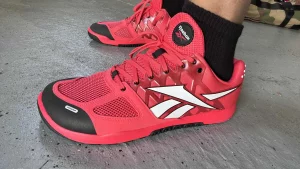Why Strongman Competitions Use Sandbags

Strongman competitions are a test of strength, endurance, and toughness. They push athletes to their limits and require them to overcome challenges that seem impossible to the average person. One of the most challenging events in these competitions is sandbagging. While most people see sandbags as a heavy load that needs to be carried from one place to another, strongmen see them as a fun and exciting challenge that they eagerly look forward to.
In this article, we’ll explore the tough and fun art of sandbagging, the ultimate test of strength and endurance, and the history of sandbags in strongman sports.
Table of Contents
The Tough and Fun Art of Sandbagging
I use sandbag extensively for my workouts, and have found them to be an effective equipment for overall fitness. On a more professional level sandbagging is a unique event in Strongman competitions. It requires athletes to carry heavy bags of sand from one point to another, often over a set distance or time limit. What makes this event challenging is the unpredictability of the bags. Unlike barbells or dumbbells, sandbags are not evenly distributed, making them difficult to balance and carry. Moreover, the weight and size of the bags can vary, adding another layer of challenge to the event. But despite all these challenges, sandbagging is a fun and exciting event that strongmen look forward to.
The Ultimate Test of Strength and Endurance
Sandbagging is not just about lifting heavy bags of sand; it’s about pushing yourself to your limits and beyond. It requires a combination of strength, endurance, and mental toughness. The sandbags at these competition have no handles or tags that the athletes can use to lift them. Athletes need to have a strong grip, upper body strength, and the ability to carry heavy loads over long distances. They also need to have the mental toughness to push through the pain and discomfort that comes with carrying heavy bags of sand. And since sandbags are often not uniform in shape, athletes need to have excellent balance and coordination to carry them without stumbling or falling.
These competitions test the athletes’
- Functional strength: Sandbag training closely mimics real-world tasks that require functional strength. In many daily activities or work scenarios, objects that need to be lifted or carried do not have a uniform shape or handles like traditional weights. Sandbags simulate these irregular loads, forcing competitors to engage different muscle groups and stabilizers to manage the shifting weight and shape of the bag.
- Grip strength: The irregular shape and shifting nature of sandbags require a strong grip to maintain control. The lack of handles challenges the grip strength of competitors, as they need to rely on their fingers, hands, and forearms to secure and manipulate the bag. This aspect is crucial as grip strength plays a significant role in many strongman events.
- Core stability: Lifting and carrying sandbags require considerable core stability and engagement. The shifting weight of the sandbag challenges the lifter to maintain proper posture and balance, activating the core muscles to stabilize the spine and prevent excessive movement.
- Mental toughness: Sandbag training is physically demanding and mentally challenging. Competitors must push through the discomfort and fatigue caused by the shifting and uneven weight distribution. The mental fortitude required to overcome these challenges is an important aspect of strongman competitions.
Training for Strongman
Strongman training is not for the faint of heart. Building and gaining strength takes a lot longer than building cardio endurance. So strongman athletes take years to train for the competitions. And continually training for strongman and maintaining leaderboard is even more harder. All of the athletes pay close attention to what they eat, how they workout to maximize performance, and overall fitness, to name a few aspects of their training. And even the best of athletes, in spite of their careful planning, do not get to complete these competitions.
There is a rotating roster of leaders at Strongman events, and you can see how the world’s three strongest men train for one of the Strongman event – the bag toss.
From Sacks of Grains to Heavyweights: The History of Sandbags in Strongman Sports
While the exact origins are unclear, sandbag training has been used by strongman competitors for decades. As the sport of strongman evolved, athletes began using sandbags as a way to test their strength and endurance. Today, sandbagging is a popular event in strongman competitions around the world. The bags used in these competitions can weigh anywhere from 50 to 300 pounds, and athletes are required to carry them over a set distance or time limit. Sandbagging is a true test of strength and endurance.
Here is a brief overview of the history:
- Functional strength training: Sandbag training has long been recognized as a valuable method for developing functional strength. In the early days of strongman competitions, strength athletes sought ways to enhance their performance in real-world tasks that required lifting and carrying irregularly shaped objects. Sandbags provided a practical solution to mimic these demands and improve overall strength.
- Training variation: Strongman athletes are known for their innovative and unconventional training methods. In the pursuit of well-rounded strength, competitors began incorporating sandbag exercises to add variety to their training routines. The unique challenges posed by sandbags helped athletes develop a broader range of strength and athleticism.
- Early strongman events: Sandbags were used in the early strongman competitions as a way to test competitors’ overall strength and functional capabilities. The events would involve lifting, carrying, loading, or throwing sandbags of various sizes and weights. These challenges showcased the strength, endurance, and versatility of the athletes, making sandbags an integral part of the sport.
- Evolution of strongman events: Over time, strongman competitions evolved, and standardized events were established. Sandbags became a regular feature in many events, such as the “Carry and Load” or “Loading Race,” where athletes have to lift and carry sandbags of different sizes and weights over a specified distance and then load them onto platforms. Sandbags were also used in events like the “Overhead Press,” where competitors had to clean and press a sandbag overhead for repetitions.
- Popularity and mainstream recognition: Sandbag training gained popularity outside of strongman sports as well. Fitness enthusiasts, athletes from various disciplines, and military personnel recognized the benefits of sandbag training for functional strength and conditioning. As a result, sandbags became widely adopted in strength and conditioning programs, further solidifying their place in the fitness industry.
Today, sandbags continue to be an integral part of strongman competitions and strength training in general. They provide a unique training stimulus, challenging athletes both physically and mentally, and remain a symbol of the functional strength and versatility that strongman sports embody.
Parting Thoughts
Sandbag events may seem like a simple event, but it’s far from it. It’s a true test of strength and endurance that requires athletes to push themselves beyond their limits. But despite all the challenges, sandbagging is a fun and exciting event that both athletes and fans enjoy. Whether you’re a seasoned strongman or just starting, sandbagging is an event that’s worth trying. So, if you’re up for the challenge, grab a sandbag and see what you’re made of. You can also follow the guide to create your own sandbag workouts.
Hope you found this useful. Check out my other posts as well.




